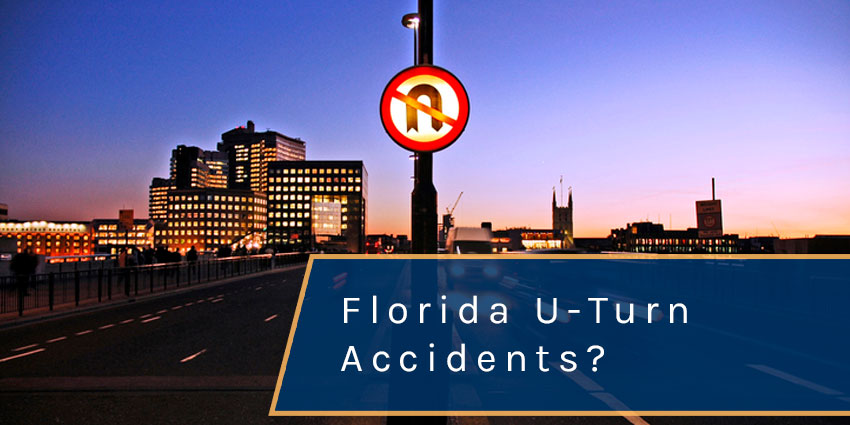An improper or reckless U-turn has the potential to cause catastrophic or severe injuries and fatalities. If you were injured in a Florida U-turn accident, you might be eligible to seek compensation for your losses.
Table of Contents
Is It Legal for Drivers to Make U-Turns in Florida?
U-turns are legal in Florida as long as they are done correctly. On the contrary, if a driver makes a U-turn with any of the following conditions, it might be considered an illegal U-turn:
- The driver made a poor judgment call to execute an unsafe U-turn
- There is clear signage prohibiting U-turns
- The driver needs to interfere with oncoming traffic to complete the U-turn
- There is no way to safely execute a U-turn in a specific designated area
Busy Intersections Are Especially Dangerous for U-Turns
Making U-turns at busy intersections is especially dangerous. For example, consider the intersection of US 301 and Gibsonton Drive – one of the busiest intersections in Hillsborough County. Many drivers avoid this intersection, when they can, but sometimes that’s not possible. This particular intersection has had many near-accidents and collisions.
Traffic data shows that this intersection is a highly problematic area, which many believe is due to the U-turn setup. Drivers at this intersection make right turns simultaneously with drivers making U-turns in the same direction. That means someone has to stop or a collision results. FDOT officials agree that this setup can get confusing for drivers because those making a U-turn are supposed to yield to drivers making a right turn. However, this can be a confusing distinction for the person making a U-turn because they can’t see the signal of the person making a right turn.
Determining Fault in a Florida U-Turn Accident
While U-turns are legal under certain circumstances, that doesn’t make them less dangerous. Even legal U-turns have caused fatalities on Florida’s roadways, making it more challenging to determine fault in a U-turn accident. So, who is at fault in a Florida U-turn accident?
Usually, it’s the fault of the person who made the U-turn (but not always). The driver making a u-turn most likely had to make the maneuver into oncoming traffic. There are two scenarios when the driver performing the u-turn is at fault:
- If the driver misjudges their ability to complete the turn in time. This would be a violation of Florida’s u-turn law that mandates drivers to make u-turns that do not interfere with oncoming traffic.
- When a driver miscalculates the amount of space they have to make a u-turn, they may have to make a three-point turn. Consequently, the oncoming traffic is more likely to collide with the u-turn vehicle while they are reversing.
Additional Factors to Consider When Determining Liability for a U-Turn Accident in Florida
Your attorney can help investigate the crash to find out and establish who is liable for the accident. Here are some factors to consider when determining liability:
- Did the person making a u-turn break any laws while making the turn?
- Did the person making a u-turn commit any traffic violations to make the turn?
- Did the driver hit you while making a u-turn?
- Who had the right of way? Did you have the right of way and collide with a driver making a u-turn?
- Did the u-turn driver fail to yield to a pedestrian or oncoming traffic?
- Did the driver make every reasonable effort to avoid a collision while making a u-turn? Regardless of who legally has the right of way, all drivers have a duty to drive in a prudent and cautious manner to avoid harming others. Failure to do so is considered driver negligence.
Even if you are partially to blame for a U-turn accident, you might still be eligible to recover compensation. This is because Florida follows comparative negligence laws. Simply put, this law says that you can be partially at fault for an accident and still recover damages.
Florida’s U-turn Laws
Florida laws don’t give much to regulate u-turns. It simply states that u-turns are legal so long as the operator does not interfere with traffic. That leaves a lot to interpretation. To complicate matters further, U-turns are legal in many cases, making it hard to hold someone liable. You can’t simply say they made a u-turn and therefore are at fault since u-turns are legal maneuvers.
Unless a driver performed an illegal U-turn in an area that gives obvious signs prohibiting U-turns, holding them legally accountable might be tricky. This is why it’s best to hire an attorney who knows what details to look for and how to establish liability.
When Is the U-Turning Driver Not at Fault?
The person making a U-turn is not always at fault. Remember, U-turns are generally legal in Florida at green lights. However, another driver making a turn might also have a green light. This can get very confusing as both drivers appear to have the right of way.
Here are a few situations wherein the driver who made a U-turn is not automatically at fault for an accident:
- The other driver was speeding or driving recklessly
- The other driver was drunk or under the influence of drugs
- The other driver was somehow negligent and caused the crash
- Both drivers had a green light
Contact a Florida U-turn Accident Lawyer Today
If there is any question about fault after a U-turn accident, the safest and smartest action is to consult an experienced Florida car accident lawyer. You won’t benefit much from guessing your way through a legal process or trying to handle your claim independently, especially in a complicated situation like a U-turn accident. Our personal injury lawyers can review your case and identify all liable parties and help you get the compensation you deserve.
Call us today for a free initial case review.














